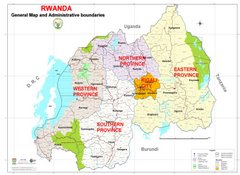
Railway staff have worked to lift overturned train carriages in the Republic of Congo in a search for more bodies two days after a train accident killed at least 76 people.
Denis Sassou Nguesso, the Congolese president, travelled to oil hub of Pointe Noire on Wednesday to meet some of those affected by the disaster as a crisis unit reported 700 people injured.
"This morning, the new toll is 76 dead. The bodies are all at the morgue in Pointe Noire," a crisis unit official said.
Amid the stench of rotting bodies and of fish that was being transported on the train that derailed Monday evening, about 100 railway employees cleared the way for a crane to lift eight overturned carriages.
The government issued a provisional toll on Tuesday of 48 dead, with a final tally only possible after all the carriages have been cleared, and announced three days of national mourning starting on Friday.
'Overloaded train'
Witnesses said the crowded train flew off the tracks after hurtling into a bend at full speed near Yanga, about 60km east of the southern coastal city of Pointe Noire.
"First we heard what we thought was a big explosion," Fabrice Malonga, a local on the scene, said.
grim history
Congo-Ocean Railway
Built between 1921 and 1934 by French
At least 17,000 people died building the railway
The line was closed in the late 1990s during the country's civil war
At least 50 people were killed in a 2001 accident
10 died in 2003 accident when a train derailed
In 2007, about 100 people died in an accident
"I saw bodies of children, older people. The carriages were full. We took the wounded to the road to wait for help."
Some of the injured had left Point Noire hospitals by Wednesday but about 160 people remained, Simon Edika, the area's public-relations director, said.
The government has blamed the accident on the colonial-era track on excessive speed.
Joseph Sauveur El Bez, managing director of Chemin de fer Congo-Ocean (CFCO), the railway operator that runs the train, put the crash down to driver error.
But he acknowledged that the high death toll was "because the train was overloaded. There were too many passengers."
"The train was fine. The track was in good condition," he said.
Non-governmental organisation activists demanded an inquiry and accused the government of neglecting the country's infrastructure.
Past deaths
The 510km CFCO line, also known as the Congo-Ocean Railway, is the main link between the capital Brazzaville and Pointe-Noire on the Atlantic and mainly follows the Congo river.
It was built between 1921 and 1934 during French colonial rule and thousands of Africans are said to have died making the railway.
At least 50 people were killed on the same line in 2001, many of them burned to death, when two trains collided at Mvougounti, about 75km east of Pointe Noire.
In August 2007, about 100 people died when a passenger train crashed into a freight train, also at Mvougounti.
The lack of roads and the dysfunctional railway system between the main towns make travel difficult and contribute to the high cost of food and imported goods in Brazzaville and throughout neighbouring land-locked nations.
Chinese engineers started work late last year on a $500m road linking Pointe Noire with Brazzaville, a project that will involve crossing equatorial forests and steep mountains.
Congo, which has long exported millions of barrels of oil but remains mostly poor and suffers from poor infrastructure, is seeking to diversify its economy as oil reserves wind down.

No comments:
Post a Comment